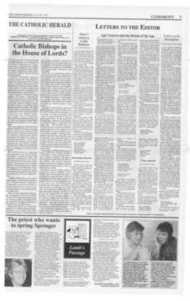Page 8, 18th June 1999
Page 8

Report an error
Noticed an error on this page?If you've noticed an error in this article please click here to report it.
Tags
Share
Related articles
********************* Mainly For Women *********************
A Bad
Charteri1ouse Chronicle
Churches Of The Nation
Hobbies Instead Of Parties
Beauty is in the eye of the needle
Modernist vandals destroyed some of our finest church embroidery, says Brian Brindley. Fortunately, all is not lost
All Things Bright and Beautiful: English Church Embroidery 1833-1953 by Mary Schoeser and others, Watts & Co Ltd, £22.99
THIS SUMPTUOUS paperback is crammed with lovely colour photographs, 150 of them, of all sorts of church embroideries, some in closeup detail, some of fullyadorned altars as complete compositions.
These beautiful works of art have not been properly appreciated as such, for a number of reasons. For one thing, vestments and frontals are normally viewed from a respectful distance; only those with access to sacristies can enjoy their often miniaturelike detail.
Fashion has played its mischievous part: the love of continental Catholicism encouraged by Cardinal Manning and Fr Faber has led many people, Anglicans as well as Catholics, to prefer cheap and cheerful massproduced goods imported from Belgium, France, Italy and Germany, to the painstaking and costly products of English workrooms. Furthermore, in the past 50 years a spirit of vandalism has prevailed in both Churches (though not as disastrously in the C of E as in the Catholic Church) with the result that many fine vestments and furnishings have been (God forgive us!) thrown away, cut up, or even burned.
Finally, it must be admitted that, after the time of Pugin, an unappealing palette of "aesthetic" colours was in use: green was greengage or olive, red was oxblood or rust, violet was indigo or puce; when white was called for, an unpleasant dark cream was preferred, which had a way of looking grubby after a few years' use. In our day we can say, with Reginald Bunthome, "I do not care for dirty greens/By any means".
The terminus a quo of 1833 is significant as the date of the beginning of the Oxford Movement, to be followed two years later by the reception of AWN Pugin into the Catholic Church. The terminus ad quem of 1953 seems to be arbitrarily chosen, but it means that we are spared the worst excesses of post-war design and craftsmanship. This book is sub-titled The Watts Book of Embroidery, and it is published by the firm of ecclesiastical furnishers founded by three architects, Bodley, Garner, and George Gilbert Scott Jr, in 1874. (There never was a Mr Watts; the name is a Victorian jest: What's in a name?) Almost alone among the melancholy list of firms and sisterhoods that have gone out of business since 1945, Watts & Co continues to flourish. Since 1953 its presiding genius has been the redoubtable Mrs Elizabeth Hoare, Scott's granddaughter. Appalled by the philistinism and destructiveness she saw in the Church, she made it her task (aided by Fr Anthony Symondson SJ) to collect specimens of needlework that were in danger of being lost. In 1992 she was able to establish a museum of Victorian and later ecclesiastical embroidery high up in the triforium of the Anglican cathedral in Liverpool, itself designed by her uncle Giles. Mary Schoeser is the curator of that museum and the author of this book; Elizabeth Hoare is gracefully acknowledged as its inspiration. The author has been helped by contributions from other embroideresses.
I suppose it is unlikely, though not impossible, that work of the quality illustrated here will be done in the future. The opportunity, and the need, for it came with the increased leisure of the upper and middle classes in the 19th century, and their earnest wish to do good rather than to follow frivolous pursuits. This in turn led to the extraordinary fleuraison of the religious life, in both Churches, during the Victorian period; I believe that there were more religious in England in 1900 than ever there were in the Middle Ages. Leisured ladies and nuns alike needed things to do; "work" was in those days a common synonym for needlework. At the same time the Church of England was being transformed by the Oxford Movement (and not only in pukka Anglo Catholic circles: there is a telling photograph of the high altar of St George's Chapel, Windsor) and the Catholic Church was being virtually re-created after the restoration of the Hierarchy in 1850. Today, leisured ladies are few; so are vocations, and those sisters that there are have more obviously "useful" things to do.
ALL THE SAME, we have a great inheritance. Much of it has been salvaged for us by the energies of Mrs Hoare, and is here made available to us by Miss Schoeser. This book will be wanted by everyone who has anything to do with church vestments; by anyone interested in the art of embroidery; and indeed by anyone who cares for beautiful things. A veritable feast for mind and eye.
blog comments powered by Disqus













